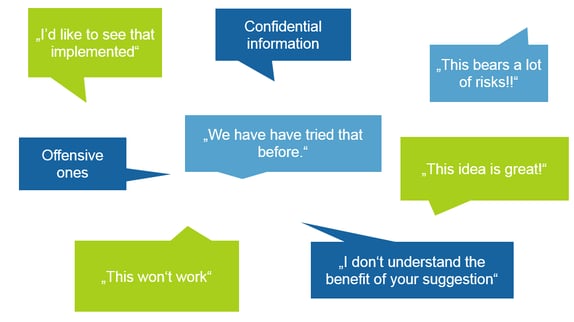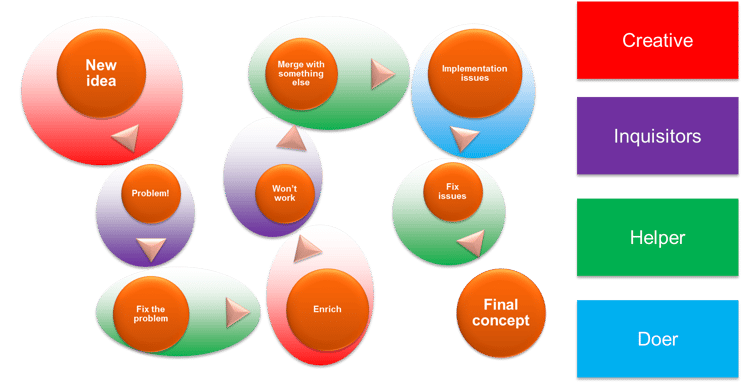A crucial aspect of an innovation management platform is its ability to foster collaboration within the community for the purpose of uncovering ideas with great potential, identifying weaknesses in others, and developing promising ideas further. The primary tool for supporting this collaboration is the discussion feature, which allows all users to leave comments on ideas that are visible to others. This sets it apart from a mere idea drop box.
Good comments provide valuable information during the review and concept development phase. But what defines a "good" comment?
What does a good comment look like?
A good comment provides additional information with further insight or fills gaps in the idea.
Or.
It may point out that the idea does not meet the criteria of the campaign question or a competitor is already working on a similar solution.
Or.
It brings a different perspective by a sales colleague raising specific customer needs, or procurement providing insights from suppliers.
Or.
Links to other ideas or existing solutions, both from within and outside the company, can also be provided, along with links to individuals who have relevant expertise and should be involved in the discussion.
Or.
Raises weaknesses and risks, indicating any remaining issues, areas where the suggested plan may not work, or where more elaboration is needed.
Or.
Asks questions about the above-mentioned areas.
All these types of comments are excellent for triggering a valuable discussion and developing an idea further.
What are not-so-good comments?

Positive comments like "This is a great idea!" or "I would love to see this implemented" are always appreciated as they acknowledge and encourage the idea contributor. However, if there are too many of these comments, they can clutter the discussion thread and not add much value.
On the other hand, negative comments like "This won't work," "We've tried this before," or "Your idea carries a lot of risk" are not the most constructive either. It's best to avoid offensive comments or accidentally sharing information that is not yet meant for a wider audience.
Rather have no comments than useless ones?
Even less constructive feedback is better than no feedback at all. In fact, comments that may seem unhelpful on the surface, such as "This won't work," can actually provide an opportunity for discussion if you ask the commenter why they feel that way or what their skepticism is based on.
Implementing a simple voting system can also help prevent uncluttering the discussion from unhelpful comments. Users can express their feelings about an idea through their vote, similar to the "like" button on many social media platforms.
While a high number of comments does not necessarily indicate the quality or helpfulness of an idea, it does show that the idea is generating a lot of attention and is worth considering.
The value of having discussions around ideas
More mature ideas
Depending on the breadth of the audience, different perspectives may arise. For example, because some individuals...:
- ...are creative thinkers who prioritize innovation over practicality, strategy, and fit.
- ...hold a functional role distinct from the idea contributor, giving them a unique perspective.
- ...may have expertise and insights from previous jobs or personal interests.
A diverse group of commenters with varying perspectives and insights can foster lively discussions, allowing ideas to mature.
Faster processing
Ideas that have been discussed by multiple people tend to be more developed and processed quickly.
To make a sound decision about pursuing or rejecting an idea, it's crucial to have comprehensive information. The more information we have, the more informed our decision-making will be. Early detection of issues, risks, or fatal flaws can save a significant amount of resources and prevent project failure.
Additionally, hidden expertise related to an idea's subject matter, customer insights, or past approaches can prove invaluable during implementation, eliminating the need to gather such information later on.
What does a valuable discussion look like?
Within an innovation community, we can distinguish four different types of personalities based on their contribution behavior. To facilitate productive conversations, it's essential to take into account all four types in communication and moderation efforts.
Below is a brief overview of the four personality types:
The Creator
Individuals with a creative inclination tend to explore novel opportunities with great enthusiasm. They exhibit a keen interest in emerging technologies or innovative business models and frequently generate fresh concepts on how to integrate them. Nevertheless, they usually have a low tolerance for minutiae and prefer not to focus on a single idea for too long.
The Inquisitor
Sometimes, the Inquisitive type may seem discouraging because they scrutinize ideas, ask challenging questions, and point out potential flaws and risks. However, their critical thinking skills are vital to the success of any project. Their questioning helps to clarify what is needed to move an idea forward, or they may identify serious issues that make it clear the idea is not feasible. Ultimately, having an Inquisitive mindset is important for achieving success.
The Helper
The Helper complements an idea by providing missing expertise, overcoming remaining challenges, and connecting ideas, people, or resources.
The Doer
The Doer type is a practical-oriented person who prefers to work with ideas that have already undergone an iterative series of improvements. They focus on formulating the essentials for turning the idea into a reality, identifying gaps, and determining which existing resources and technologies can be utilized.
A value-adding discussion around an idea could look as follows, involving all four personality types at different stages:

What triggers valuable discussions?
Communication
It is important to utilize various communication channels to emphasize that your goal is not only to receive new ideas from participants but also to encourage them to examine and provide their perspectives on other ideas through comments.
If you are running campaigns, make sure to explicitly mention them in the campaign question. Don't assume people will use the commenting feature just because it is there, so be clear about it!
If you find yourself coming up with many ideas, some of which may be duplicates, it's crucial to adapt your communication strategy to emphasize the importance of collaboration on existing ideas. This can be done through campaign reminder emails and other forms of communication.
Consider using all channels available to share your message, including webinars, posters, articles, and town hall meetings.
Seed comments
We recommend that you do not launch new campaigns to a wider audience without any content in them, especially if you are running time-restricted idea campaigns. This is because of a common human phenomenon, similar to what happens at a party when no one wants to be the first one on the dance floor. People feel uncomfortable if they are the only ones participating while others are watching. It is uncertain whether others will follow.
Therefore, it is advisable to pre-seed every campaign with some initial ideas from handpicked people from your audience.
The same goes for comments and votes. People are more likely to adopt these behaviors if they see that others have already done so.
In addition, people usually prefer examples to comprehend your message better. So, providing comments on your seed ideas and initiating some discussion can help people understand and follow the desired behavior.
Active moderation
When starting and guiding a discussion, it's crucial to have active moderation. The moderator's role is to aid the person proposing the idea by highlighting any missing elements, like an essential requirement that wasn't addressed or areas that need further elaboration.
Additionally, moderators should set the standard for behavior that we want to see from everyone else involved in the discussion. This includes making connections to other ideas or individuals with expertise related to the subject matter.
It's also helpful to reference previous attempts, whether inside or outside the organization, that are similar in nature.
Clarifying responsibilities for moderation is crucial. The innovation management team usually handles this, but depending on traffic, additional support may be necessary and others may need to be nominated to take on that role.
Many advanced innovation programs have a dedicated group of innovation advocates. These advocates are the primary supporters of the program and act as a liaison between the program and its participants. They encourage participation from all levels and act as the program's eyes and ears on the ground. It is recommended to consider recruiting moderators from this group of advocates.
Engage in a timely manner
The role of time is crucial in initiating discussions. If a person has to wait for a week to receive a response to their question or feedback on their idea, it is unlikely that a lively discussion will ensue. Furthermore, if users logging in do not witness recent platform activity, they are less likely to return frequently, as it appears that nothing noteworthy is happening on the platform that they might miss.
It is recommended that moderators participate in discussions and initiate new ones by logging in at least once a day. If you're conducting short campaigns that last only a few days, it's important to have a higher frequency of moderation and a larger group of moderators.
For instance, Volvo Trucks, one of our clients, utilized this approach in a 3-day idea campaign, where 2100 users generated over 600 ideas with more than 3000 comments. To enhance the conversation, they appointed a team of 49 moderators located around the world. A ratio of 1:5 - indicating an average of 5 comments per idea - is a satisfactory number that wouldn't have been achieved without the moderators' participation.
Involve sponsors and reviewers
When using a campaign-based approach for generating ideas, it's important to have a sponsor who owns the need that the campaign is focused on. However, sponsors are often difficult to reach due to their positions in top management. It's worth trying to persuade the sponsor to visit the campaign a few times during its runtime. This will help build confidence in the process as the audience will see that the sponsor is genuinely dedicated to the challenge and not just putting their name and photo in front of the campaign. This increased dedication from the sponsor usually results in increased participation.
It may be beneficial to involve the chosen jury members or evaluators in discussions regarding the ideas. As they will ultimately be responsible for reviewing and assessing the ideas, it is suggested that they provide input and feedback during the developmental phase. It would be wise to inform them in advance and schedule reminders in their calendars.
Rewards & Recognition
In the long run, recognition is one of the most effective motivators, not just in collaborative innovation programs. It is important to acknowledge those who submit great ideas that get implemented, but it is equally important to recognize those who make substantial contributions through comments.
Leaving out these contributors can harm your culture of collaboration and demotivate them. It is important to note that there are different types of contributors, including those who participate regularly by offering valuable comments to others' ideas. Failing to recognize their efforts may result in losing these valuable contributors over time.
It is important to reward not only idea submitters but also those who engage in lively discussions and make good comments. This applies to any other forms of rewards as well. For example, some of our clients allow idea submitters to participate in the conception or implementation phase of their ideas as a reward. If commenters have added substantial value to an idea, consider involving them too!
Watch the webinar on triggering valuable discussions in collaborative innovation.








